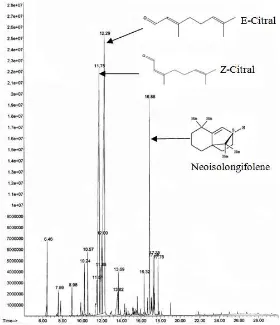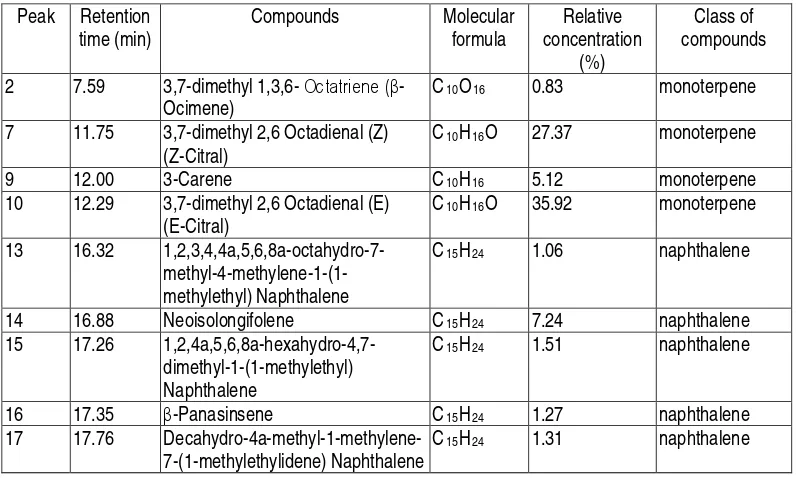BIOACTIVE COMPONENTS OF LEAF AND STALK OF LEMONGRASS (Cymbopogon citratus) ESSENTIAL OIL AND ITS ANTIOXIDANT ACTIVITY
I Nengah Kencana Putra1), Nyoman Semadi Antara 2) and Ni Made Wartini 2)
1) Study Program of Food Science and Technology, Faculty of Agricultural Technology,
Udayana University, Bali, Indonesia
2)Study Program of Agro-Industrial Technology, Faculty of Agricultural Technology, Udayana University,
Bali, Indonesia
1)Author for correspondence, E– mail: [email protected]
ABSTRACT
Lemongrass is well known for its oil and it is one of the world's best essential oil. The essential oils possess many uses, including: perfumery, cosmetics, pharmaceutical, and flavoring industries. The aim of this study was to analyze the bioactive components composition of essential oil extracted from lemon grass leaves and stalk (Cymbopogon citratus), and to evaluate their antioxidant capacity. The lemon grass samples were taken from Plaga (Bali) area (altitude of 750 m above sea level) and from Tabanan (Bali) area (altitude of 100 m above sea level). The results showed, the dominant compound in lemongrass essential oil (both extracted from stalks and leaves) was citral, a monoterpene compound. The citral was in the form of either cis (Z-citral) and trans (E-citral). The citral content of essential oil extracted from lemongrass leaves was higher than extracted from lemongrass stalk. In addition to the monoterpene, in the stalk essential oil was also found other compounds belonging to naphthalene, and alcohol. The antioxidant activity of leaves essential oil was 6279.97 µ mol trolox/100 ml sample, it was higher than the stalk essential oil (3853.62 µ mol trolox/100 ml sample).
Keyword: lemongrass, citral, antioxidant, stalk, leaf
INTRODUCTION
Lemongrass is an aromatic grass belonging to the family of Gramineae and genus of
Cymbopogon. There are two main type of lemongrass species, namely: Cymbopogoncitratus
(West Indian lemongrass), the kind often found in Indonesia; and Cymbopogon flexuosus (East
Indian lemongrass) (Jayasinha, 1999). Lemongrass is well known for its essential oil and it is
one of the world's best essential oil. Lemongrass essential oil yield ranges from 0.2 - 0.4%, and
the main component of the essential oil is citral. The essential oils possess many uses
Citral, a monoterpene, is a major constituent of lemongrass essential oil. It was known
to posses antiseptic, antimicrobial, anti-inflammatory, carminative, diuretic and central nervous
system stimulating effects (Carbajal, et al, 1989). Citral was found to possess anticancer effect
against prostate gland tumor in various strains of rats (Scolnik, 1994). Matasyoh, et al. 2010
reported, essential oil of lemongrass was active against five species of genus Aspergillus
namely: A. flavus, A. parasiticus, A. ochraceus, A. niger and A. fumigatus. Citral possesses
ant-oxidant activities which may be associated with some of the reputed beneficial effects on
human health (Cheel, et al., 2005)
The aim of this study was, to analyze the composition of bioactive components of the
essential oil of Cymbopogon citratus (lemongrass) leaf and stalk, and to evaluate their
antioxidant capacity. The lemongrass samples were taken from Plaga area (altitude of 750 m
above sea level) and from Tabanan area (altitude of 100 m above sea level).
MATERIALS AND METHODS
Plant material
Leaves and stalks of lemongrass used in this study were collected from two areas in Bali
there were Plaga (altitude of 750 m above sea level), and Tabanan (altitude of 100 m above sea
level). The materials were derived from plants that have been aged 6 months. Lemongrass
leaves and stalks were washed with clean water, packed in polyethylene plastic, then taken to
Denpasar for the essential oil extraction.
Isolation of essential oil
Extraction of lemongrass essential oil was done by using steam distillation method.
Steam used was saturated or supersaturated steam at a pressure of 1 atmosphere in which the
steam is piped to a tank of raw materials. Existing oil in the raw material will be brought together
GC-MS analysis
GC-MS analysis was carried out on the essential oil of lemongrass stalks and leaves to
find out the content of bioactive components. Gas chromatography instrument using Hp 5ms
column, with an internal diameter of 0.25 mm and a length of 30 m. The carrier gas used was
helium with a flow rate of 1 ml per minute. Injector temperature was set to 250 °C, initial oven
temperature was set to 70 ° C, the rate of temperature increasing was set to 10 °C/min, and the
final oven temperature set to 270 oC. Identification of compounds was done with the help of a
computer software using Wiley 229, NIST 12 and NIST 62 Library.
DPPH radical scavenging assay
The 1,1-diphenyl-2-picrylhydrazyl (DPPH) free radical scavenging activity of plant
extracts was determined using the method by Yen and Chen (1995). The DPPH radical
(DPPH+) solution was prepared in MeOH to make a 1 mM DPPH+ solution. DPPH solution was
further diluted with MeOH at the ratio of 1:25. The scavenging activity of the essential oil
was determined by adding 600 µ l of diluted DPPH solution and 300 µ l of each essential
oil. The absorbance reading of 0.900 ± 0.020 at 517 nm was taken exactly 4 min after
initial mixing. The essential oil were first adequately diluted to fit within the linearity range.
The absorbance of the DPPH radical without antioxidant (the control) was also measured. All
determinations were carried out in duplicate. The antioxidant capacity based on the DPPH
free radical scavenging ability of the extract was expressed as µ Mol Trolox equivalence
antioxidant capacity (TEAC) per 100 ml of essential oil.
RESULT AND DISCUSSION
Chemical composition
Lemongrass leaf essential oil
GC-MS chromatogram of lemongrass essential oil extracted from the leaves of
identified in the oil namely E-Citral, Z-Citral, and 3-Carene (Table 1). E-and Z-citral citral was the
dominant compounds found in the oil. Both compounds were classified as monoterpene. E-citral
and Z-citral is an isomer compound, where the E-citral is a compound in the form of trans
whereas Z-citral in the form of cis. E-citral is also known by other names, that is α-citral or
Geranial, whereas Z-citral also known as β-citral or Neral. In addition to citral, there was also
identified 3-Carene in minor amount. This compound is also belong to monoterpene.
GC-MS chromatogram of lemongrass essential oil extracted from the leaves of
lemongrass originating from Tabanan is presented in Figure 2. There were two compounds
identified in the oil namely E-Citral, and Z-Citral (Table 2).
The results of this study demonstrated that the essential oils of lemongrass leaves from
Plaga and Tabanan had a slightly different in chemical composition. In the essential oils of
lemongrass leaves from Plaga was found 3,7,7-trimethyl Bicyclo hept-3-ene (3-Carene), but in
the essential oil of lemongrass from Tabanan was not. This results implied that the environmental
conditions where the lemongrass planted also affects the chemical composition of its essential
oils. Tabanan is the lowland area with an altitude of about 100 m above sea level, while Plaga is
Figure 1. GC-MS Chromatogram of essential oil of lemongrass leaf from Plaga
Table 1. Bioactive compound identified in essential oil of lemongrass leaf from Plaga
Peak Retention time (min)
Compounds Molecular
formula
Relative concentration
(%)
Class of compound
6 11.61 Z-Citral C10H16O 32.93 monoterpene
7 11.78 3,7,7-trimethyl Bicyclo hept-3-ene
(3-Carene)
C10H16 3.82 monoterpene
8 12.09 E-Citral C10H16O 37,85 monoterpene
Figure 2. GC-MS Chromatogram of essential oil of lemongrass leaf from Tabanan
Table 2. Bioactive compound identified in essential oil of lemongrass leaf from Tabanan
Peak Retention
time (min)
Compounds Molecular
formula
Relative concentration
(%)
Class of compound
4 11.59 3,7-dimethyl-2,6-Octadienal (Z)
(Z-Citral)
C10H16O 36.41 monoterpene
6 12.07 3,7-dimethyl-2,6-Octadienal (E)
(E-Citral)
Lemongrass stalk essential oil
GC-MS chromatogram of essential oil extracted from the stalk of lemongrass originating
from Plaga area is presented in Figure 3. There were nine compounds identified in the essential
oil (Table 3). These compounds can be classified in to two classes, namely monoterpenes and
naphthalenes. Among these classes, monoterpene was the dominant class (69,24%)
Table 3. Bioactive compound identified in essential oil of lemongrass stalk from Plaga
Peak Retention
time (min)
Compounds Molecular
formula Relative concentration (%) Class of compounds
2 7.59 3,7-dimethyl 1,3,6- Octatriene (β
-Ocimene)
C10O16 0.83 monoterpene
7 11.75 3,7-dimethyl 2,6 Octadienal (Z)
(Z-Citral)
C10H16O 27.37 monoterpene
9 12.00 3-Carene C10H16 5.12 monoterpene
10 12.29 3,7-dimethyl 2,6 Octadienal (E)
(E-Citral)
C10H16O 35.92 monoterpene
13 16.32
1,2,3,4,4a,5,6,8a-octahydro-7- methyl-4-methylene-1-(1-methylethyl) Naphthalene
C15H24 1.06 naphthalene
14 16.88 Neoisolongifolene C15H24 7.24 naphthalene
15 17.26
1,2,4a,5,6,8a-hexahydro-4,7-dimethyl-1-(1-methylethyl) Naphthalene
C15H24 1.51 naphthalene
16 17.35 β-Panasinsene C15H24 1.27 naphthalene
17 17.76
Decahydro-4a-methyl-1-methylene-7-(1-methylethylidene) Naphthalene
C15H24 1.31 naphthalene
GC-MS chromatogram of lemongrass oil extracted from the stalk of lemongrass
originating from Tabanan is presented in Figure 4. There were five compounds identified in the
oil (Table 4). These compounds can be classified in to three classes, namely: monoterpene,
alcohol, and naphthalene. Among these classes, monoterpene was the dominant class (76,93
Figure 4. GC-MS Chromatogram of essential oil of lemongrass stalk from Tabanan
Table 4. Bioactive compound identified in essential oil of lemongrass stalk from Tabanan
Peak Retention
time (min)
Compounds Molecular
formula
Relative concentration (%)
Class of compound
4 11.59 3,7-dimethyl-2,6-Octadienal (Z)
(Z-Citral)
C10H16O 33.05 monoterpene
6 12.06 3,7-dimethyl-2,6-Octadienal (E)
(E-Citral)
C10H16O 43.88 monoterpene
9 17.34
1,2,3,3a,4,5,6,7-octahydro-1,4-dimethyl-7-(1-methylethenyl)-,
[1R-(1α,3aβ,4α,7β)] Azulene
C15H24 1.23 naphthalene
10 17.39 Patchouli alcohol C15H26O 1.28 alcohol
11 17.75
Decahydro-4a-methyl-1-methylene-7-(1-methylethylidene),(4aR-trans) Naphthalene
C15H24 0.94 naphthalene
Antioxidant activity
The stable radical DPPH has been used widely for the determination of primary
and fruit extracts, and food materials. The assay is based on the reduction of DPPH radicals in
methanol which causes an absorbance drop at 515 nm. In this study, the antioxidant activity was
expressed as trolox equivalents antioxidant capacity value (µ mol trolox/100 ml sample).
Trolox equivalent antioxidant capacity (TEAC) value of essential oil made from the stalk
or leaves of lemongrass collected from Plaga area or Tabanan area is presented in Table 5. The
essential oil made from leaf had higher antioxidant activity than that made from stalk. These
results were found in both the lemongrass derived from Tabanan area and from Plaga area. it is
suspected because of the content of citral in lemongrass leaf oil is higher than in stalk
lemongrass oil. The citral content of the oil made from lemongrass leaves collected from Plaga
and Tabanan areas were 70.78 and 79.73, respectively, whereas the citral content of oil made
from lemongrass stalk collected from Plaga and Tabanan areas were 63.29% and 76.93%
respectively. Citral is a compound in lemongrass oil which possesses antioxidant activities
(Cheel, et al., 2005).
Table 5. TEAC value of leaf and stalk of lemongrass essential oil from Plaga and Tabanan (µ mol trolox/100 ml sample)
No Sample Origin
Plaga Tabanan
1 Leaf essential oil 8949.62 3610.31
2 Stalk essential oil 4823.64 2883.61
CONCLUSION
In conclusions, this study showed that the dominant compound in lemongrass essential
oil (both made from stalks and leaves) was citral, a monoterpene compound. Citral in the
lemongrass essential oil was exist in either cis form (Z-citral) and trans form (E-citral). in addition
to monoterpene, in the essential oil of lemongrass stalk was also identified other compounds
belonging to naphthalene, and alcohol. The citral content of essential oil made from lemongrass
leaves was higher than made from lemongrass stalk. Antioxidant activity of essential oil made
REFERENCES
Carbajal D., A. Casaco, L. Arruzazabala, R. Gonzalez, Z. Tolon. 1989. Pharmacological study of Cymbopogoncitrates leaves. J. Eth-nopharmacologyl 25:103-7.
Cheel, J., C. Theoduloz, J. Rodriaguez, and G. Schmeda-Hirsch-mann. 2005. Free radical scavengers and antioxidants from lemongrass (Cymbopogon citratus (D.C.) Stapf.). J. Agric. Food Chem., 53: 2511–2517
Jayasinha P. 1999. Lemongrass. Industrial Technology Institute, Colombo. p. 1 - 10
Matasyoh, J.C., I.N. Wagara, J.L. Nakavuma and A.M. Kiburai. 2011. Chemical composition of Cymbopogoncitratus essential oil and its effect on mycotoxigenic Aspergillus species. African Journal of Food Science 5(3): 138-142
Scolnik M.D., C. Servadio, A. Abramovici. 1994. Comparative study of experimentally induced benign and atypical hyperplasia in the ventral prostrate of different rat strains. J. Andrology 15:287-97.
Yen G.C, H.Y. Chen. 1995. Antioxidant Activity of Various Tea Extracts in Relation to Their Antimutagenicity. J. Agric. Food Chem. 43(1): 27-32





